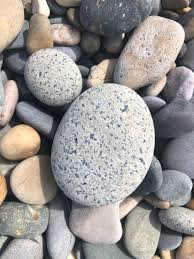The Ramson Cliff epidiorite glacial erratic, at c 80 m above sea level
Yesterday I took a look at our old friend Tim Daw's blog site. It's worth looking at now and then, since it does occasionally contain items of interest. Anyway, I was greatly entertained by his latest full-frontal attack on my credibility -- demonstrating yet again his lack of understanding of natural processes and his tendency of shooting from the hip when a little more time might have spent on researching his target.
So what is he on about this time? Well, it's a long piece devoted (as far as I can understand it) to demonstrating that there are no erratics around the Bristol Channel other than those found on the shore platforms between present day high and low tide marks. He is apparently obsessed with a statement I made about many erratics being found around the Bristol Channel coasts above 100m. I stand by that, and am more than a little irritated by Tim's selective use of citations and his ignorance of the literature. My information comes from abundant sources, most of which are cited on my blog and in my published articles.
Some of the erratics are glacial, and some are not. I have already drawn attention in my blog to the Shebbear and Berry House erratics, which appear to be sarsens. Ice may or may not have been involved in their emplacement, but they are clearly not in their "original" positions.
https://brian-mountainman.blogspot.com/2024/11/more-on-shebbear-erratic-boulder.html
https://brian-mountainman.blogspot.com/2024/11/the-berry-house-boulder-north-of.html
I accept that the Harmer map of erratics does not show erratics in the Ilfracombe area. Apologies for that. My version of the map was clearly a copy of a copy, and what I thought was a dot indicating a recorded erratic was in fact a tight contour line just below the letter "e" in "Ilfracombe". It's interesting that Harmer did not show any of the erratics in the Saunton - Croyde area either -- even though they had been recorded well before 1928 by other geologists. For example:
Pengelly, J. 1892. The granite boulder on the shore of Barnstaple Bay, North Devon. Transactions of the Devonshire Association, 6, 211-222.
Tim claims -- quite falsely -- that there are no erratic boulders at Lundy, Court Hill or Nightingale Valley, and that the erratics at Fremington, Baggy Point and elsewhere can be ignored because they are under the 100m contour. I just do not understand why he is so obsessed with the 100m contour nonsense, because I did not claim that there are vast numbers of glacial erratics above this level on the coasts of Devon, Cornwall and Somerset. If you want me to be pedantic, I referred in my 2024 Limeslade Boulder article to "the shores of the Bristol Channel" without specifying which ones I was talking about.
Anyway, I am not going to waste my time on this -- but I will simply reiterate that according to Prof Nick Stephens there are high level glacial erratics near Ilfracombe, that according to Rolfe et al there are high-level glacial erratics on Lundy Island, and that according to Gilbertson and Hawkins there are drift deposits containing erratics up to 122m OD at Portishead Down and elsewhere. The same authors refer to "erratic rich drifts" on the high-level plateau surfaces of the Cotswolds above Bath, and on the Mendips, "at and above 200m." (p 186) Geoffrey Kellaway and others demonstrated the same thing in articles published around 1971-72.
If ice from the west affected these areas on the southern shore of the Severn Estuary up to and above 200m, it is a statement of the obvious that the ice surface up-glacier (ie to the west) must have been even higher. It should come as no surprise to anybody that in those circumstances, on at least one occasion, glacial erratics both large and small must have been dumped on all of the shores of the Bristol
Channel. We know about some of them, and others no doubt are still to be found.
I just cannot understand why Tim Daw, and his dear friends Ixer, Bevins, Pearce and Scourse, should have a problem with that..............
Madgett, P.A. and Inglis, A.E. 1987. A re-appraisal of the erratic suite of the Saunton and Croyde Areas, North Devon. Transactions of the Devonshire Association, 119, 135-144.








































